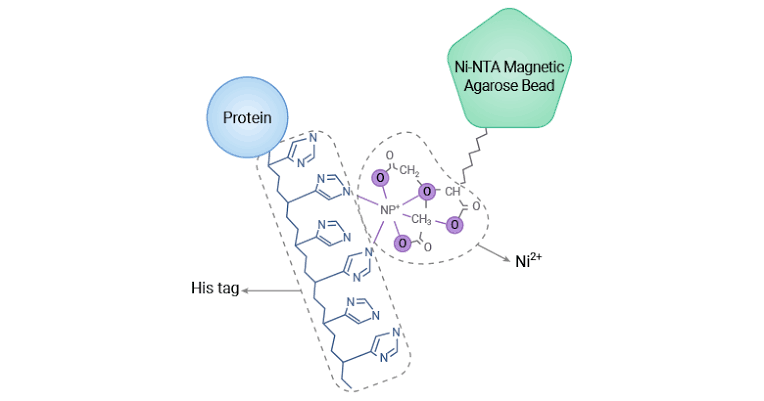
Hyper expression of poly-histidine-tagged recombinant proteins and their purification using Ni affinity resin involves several key steps. This process is widely used in molecular biology to produce and isolate proteins for various applications, including structural studies, functional assays, and therapeutic development. Below is a detailed step-by-step explanation of the procedures involved.
Step 1: Gene Cloning
- Select the Gene of Interest: Identify the gene encoding the protein you wish to express.
- Design Primers: Create primers that include a sequence encoding a poly-histidine tag (usually 6x His) at either the N-terminus or C-terminus of your gene.
- PCR Amplification: Use polymerase chain reaction (PCR) to amplify the gene with the histidine tag included in the product.
- Vector Selection: Choose an appropriate expression vector (e.g., pET, pGEX) that allows for high-level expression in a suitable host organism, typically E. coli.
- Ligation: Insert the PCR product into the vector using restriction enzymes and ligation techniques.
Step 2: Transformation
- Prepare Competent Cells: Use chemically competent or electrocompetent E. coli cells (e.g., BL21(DE3)) for transformation.
- Transform Cells: Introduce the recombinant plasmid into competent cells via heat shock or electroporation.
- Recovery: Allow transformed cells to recover in SOC medium for about 1 hour at 37°C.
Step 3: Screening Transformants
- Plate on Selective Media: Spread transformed cells on agar plates containing an antibiotic corresponding to your plasmid’s resistance marker (e.g., ampicillin).
- Colony Screening: Pick colonies and screen them via colony PCR or restriction digestion to confirm successful insertion of your gene.
Step 4: Protein Expression
- Inoculate Cultures: Pick positive colonies and inoculate them into LB broth containing antibiotics; grow overnight at 37°C with shaking.
- Induction of Protein Expression:
- Dilute overnight culture into fresh LB medium (1/100 dilution).
- Grow until OD600 reaches approximately 0.6–0.8.
- Induce protein expression by adding IPTG (isopropyl β-D-1-thiogalactopyranoside) to a final concentration of 0.1–1 mM.
- Continue incubation for an additional 4–24 hours at optimal temperature (often at reduced temperatures like 16°C for better folding).
Step 5: Cell Harvesting
- Centrifugation: Harvest cells by centrifugation at around 4,000–6,000 x g for 15 minutes at 4°C.
- Resuspension: Resuspend cell pellets in lysis buffer (commonly containing Tris-HCl, NaCl, imidazole, and protease inhibitors).
Step 6: Cell Lysis
- Lyse Cells:
- Use mechanical methods such as sonication or French press, or chemical methods with lysozyme followed by freeze-thaw cycles.
- Keep samples on ice during lysis to prevent protein degradation.
Step 7: Clarification
- Centrifuge Lysate: Centrifuge lysate at high speed (around 12,000 x g) for about 30 minutes at 4°C to remove cell debris.
- Collect Supernatant: Carefully collect the supernatant containing soluble proteins.
Step 8: Ni Affinity Chromatography
- Prepare Ni-NTA Resin:
- Equilibrate Ni-NTA resin with binding buffer (typically composed of Tris-HCl, NaCl, and low imidazole concentration).
- Load Sample onto Column:
- Apply clarified lysate to the column containing equilibrated Ni-NTA resin; allow binding under gravity flow or low pressure.
- Wash Steps:
- Wash column with wash buffer containing higher imidazole concentrations (20–50 mM) to remove non-specifically bound proteins while retaining His-tagged proteins.
- Elution of His-Tagged Protein:
- Elute bound protein using elution buffer containing high imidazole concentration (typically around 250 mM). Collect fractions during elution.
Step 9: Analysis and Characterization
- SDS-PAGE Analysis:
- Analyze eluted fractions using SDS-PAGE to assess purity and size of recombinant protein.
- Western Blotting (Optional):
- Perform Western blotting using anti-His antibodies if further confirmation is needed regarding protein identity.
- Concentration and Storage:
- Concentrate purified protein using ultrafiltration or dialysis if necessary; store at appropriate conditions (-80°C or lyophilized).
Conclusion
The hyper expression and purification of poly-histidine-tagged recombinant proteins using Ni affinity chromatography is a powerful technique that allows researchers to produce large quantities of pure proteins efficiently for various applications in research and industry.







